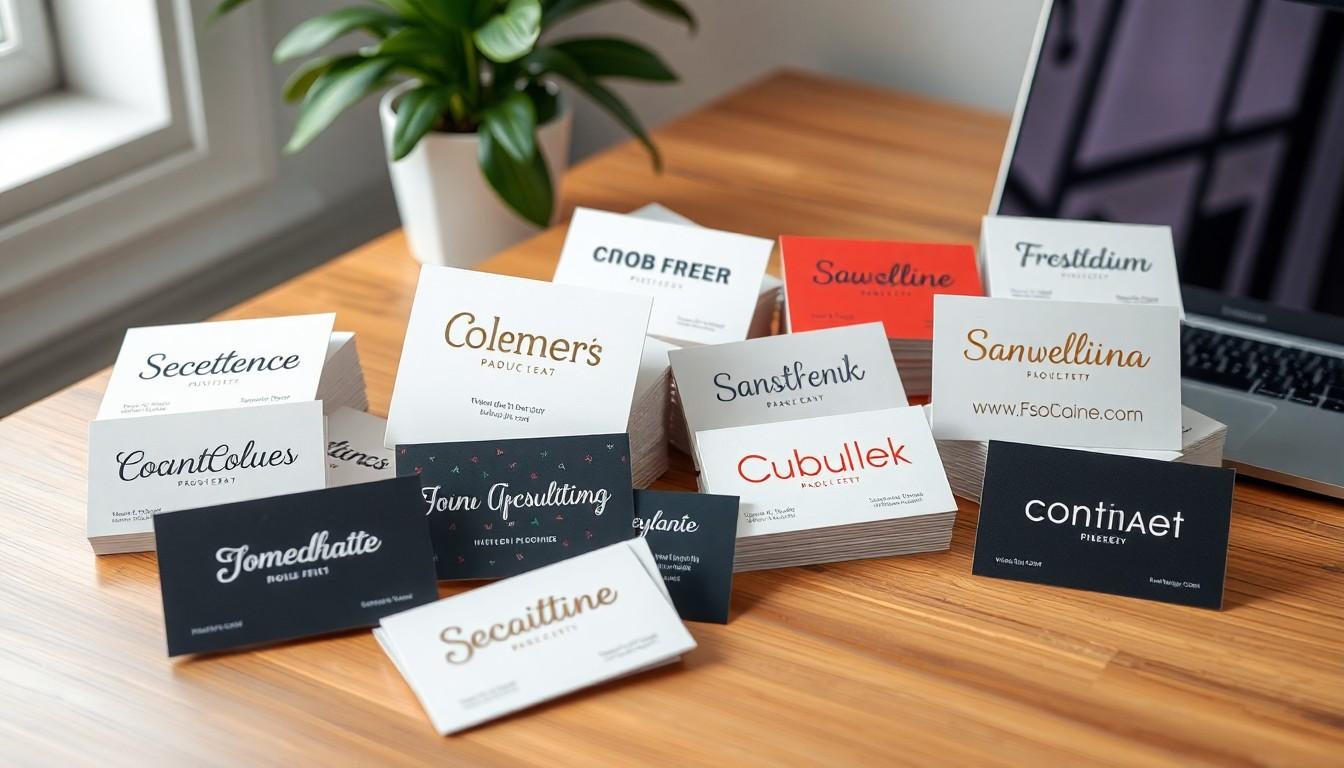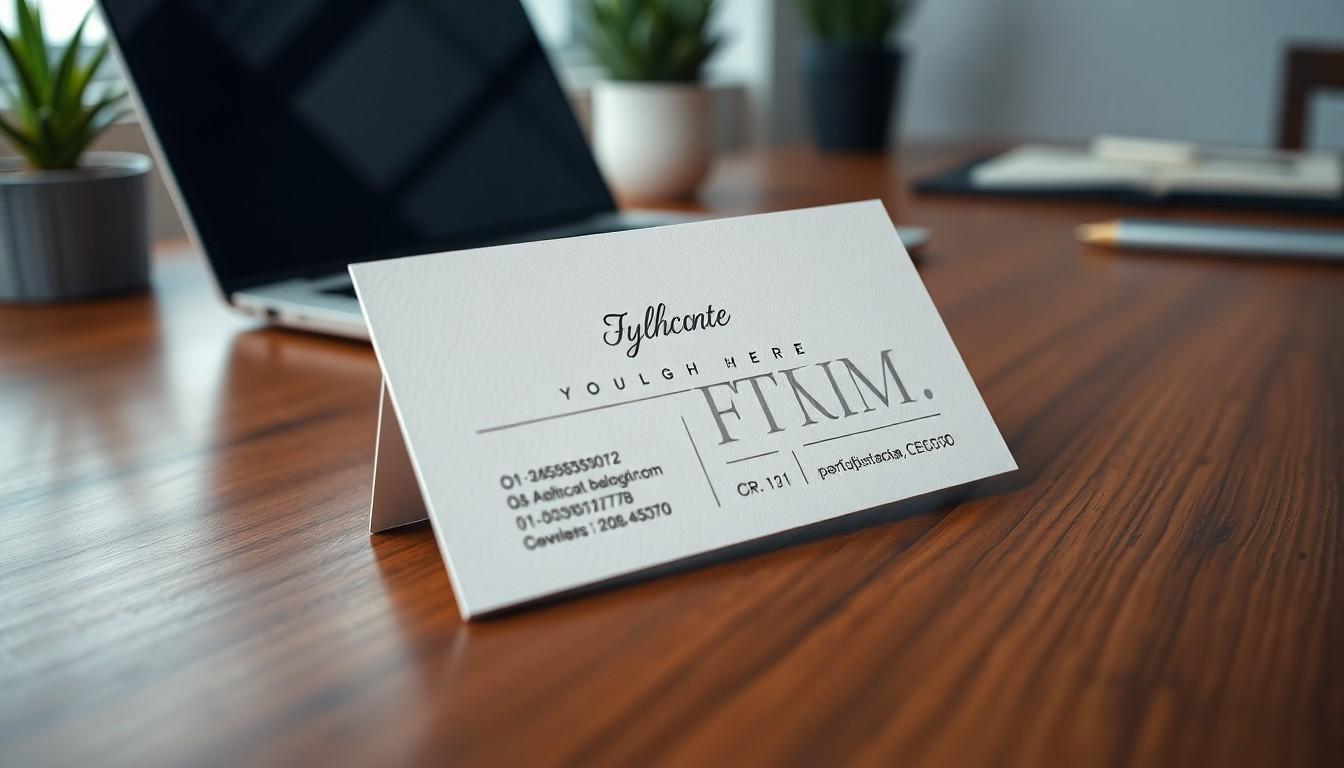TABLE OF CONTENTS
- Significance of Font Choice for Business Cards
- Key Considerations When Selecting Fonts for Business Cards
- Trendy Font Styles for Business Cards
- Which Font is Ideal for Business Cards?
- Merging Business Card Fonts with Logos or Graphics
- Final Thoughts
- Frequently Asked Questions
- Home
- content hub
- What Font is Best For Business Cards?
What Font is Best For Business Cards?
Matthew Prince
Content Writer
Jul 14, 20233912 views
Jul 14, 20233912 views

TABLE OF CONTENTS
- Significance of Font Choice for Business Cards
- Key Considerations When Selecting Fonts for Business Cards
- Trendy Font Styles for Business Cards
- Which Font is Ideal for Business Cards?
- Merging Business Card Fonts with Logos or Graphics
- Final Thoughts
- Frequently Asked Questions
Choosing the right font for your business card can feel overwhelming. With countless options available, it’s crucial to find a typeface that not only reflects your brand’s personality but also ensures readability and professionalism. After all, your business card often serves as the first impression you make on potential clients or partners.
In this article, we’ll explore the best fonts for business cards, breaking down the characteristics that make certain fonts more effective than others. From classic serif fonts that convey tradition to modern sans-serif options that exude cleanliness, we’ll guide you through selecting the perfect font that aligns with your brand identity and stands out in a competitive landscape. Let’s dive into the art of font selection and transform your business card into a memorable representation of your brand.
Significance of Font Choice for Business Cards
Font choice significantly influences brand perception, readability, and professionalism. A carefully selected font reflects our brand's personality and values while ensuring essential information remains easily digestible for potential clients. For instance, using a font like Times New Roman can convey tradition, making it suitable for formal industries, while a sans-serif font like Helvetica presents a modern, clean appearance ideal for contemporary businesses.
Selecting the right font enhances the memorability of our business cards. Well-chosen fonts leave a lasting impression, distinguishing our brand in a competitive landscape. We recommend pairing a serif font for body text with a sans-serif for headings, as this combination creates a balanced visual contrast.
Proper sizing also plays a crucial role. For essential information, font sizes between 10pt to 16pt ensure readability. In contrast, secondary details shouldn't drop below 8pt to maintain legibility. Adhering to these guidelines contributes significantly to the overall impact of our business card design.
We recognize that a clean, professional font fosters trust with our audience. By prioritizing legibility, we can ensure that contact details remain easy to read even at smaller sizes. Avoiding overly decorative or complex fonts prevents confusion and communicates professionalism.
Leveraging custom printing solutions from 4OVER4 elevates our brand presence by helping us choose the perfect font that aligns with our image. We can explore various font styles through their design templates, which provide valuable insights into combinations and typographies that work well together.
For tailored business cards, we can find inspiration and guidance on the 10 best fonts for business cards. This resource assists us in making informed decisions about fonts that enhance our brand's image. We emphasize the importance of font choice as a vital component of our overall design strategy.
Utilizing the right fonts in our custom printing projects facilitates a cohesive brand image and resonates with our target audience. By emphasizing clarity and sophistication in our card designs, we can effectively communicate our message and strengthen our brand identity.
With the right partnerships and tools, such as those provided by 4OVER4, we can confidently create impactful business cards that align with our brand's essence. To begin this journey, we can explore various business card printing options.
Key Considerations When Selecting Fonts for Business Cards

Selecting the right font for business cards significantly impacts brand perception. We focus on several key factors to enhance visibility and convey professionalism.
Legibility
Legibility tops our priorities. We opt for fonts that are easy to read, even at smaller sizes. Fonts featuring clean lines and sufficient spacing between letters enhance legibility. Overly ornate scripts or decorative fonts detract from essential information, creating confusion for potential clients.
Font Sizes
Appropriate font size plays an essential role in design. We recommend using font sizes between 10pt to 16pt for vital contact details. For secondary text like taglines or additional information, sizes between 8pt to 10pt maintain clarity. Ensuring that all text remains crisp and legible enhances the overall impact and professional appearance of the card.
Font Weights
Font weight influences visibility and clarity. We may choose from various weights, such as bold, medium, and thin. Using a bold font for key elements and a lighter weight for secondary information ensures a balanced and clear presentation.
Branding Considerations
Brand identity is crucial in font selection. We align our font choice with the character and spirit of our brand. For instance, serif fonts like Times New Roman and Garamond convey tradition, while sans-serif fonts like Helvetica and Futura embody modernity. Pairing a serif font for body text with a sans-serif for headings creates an effective visual contrast.
Professional Design Solutions
Leveraging custom printing solutions from 4OVER4 helps elevate our brand presence. Their expertise simplifies the process of selecting suitable fonts and provides access to design templates that align with our vision. By focusing on the right elements, we enhance our business cards' aesthetic and functionality, ensuring potential clients can easily access our information.
By considering these essential elements, we improve the chances of making a memorable first impression with our business cards. For further insights on font choices, explore the 10 best fonts for business cards.
Trendy Font Styles for Business Cards

Selecting trendy font styles for business cards enhances brand presence and guarantees a distinct identity. Here are some popular styles that effectively communicate messages and values.
Serif Fonts
Serif fonts, like Garamond and Baskerville, convey tradition and authority. These fonts feature small lines at the ends of strokes, providing a classic feel that works well for formal industries. Their readability and timeless appearance make them ideal for conveying professionalism.
Sans-Serif Fonts
Sans-serif fonts such as Arial, Helvetica, and Myriad Pro deliver a sleek, modern look. Their clean lines and versatility adapt to various business types, from tech startups to service-based companies. Using san-serif fonts improves legibility, ensuring essential information is easily discernible, especially in smaller sizes.
Script Fonts
Script fonts, like Fabfelt Script and Broadway, add a creative flair, making them suitable for brands that emphasize artistry. These fonts offer a personal touch that can foster connections, especially for self-employed individuals or small business owners aiming to build a personal brand. Their warmth encourages potential clients to reach out.
Vintage Fonts
Vintage-style fonts, like Worn Type, evoke nostalgia and craftsmanship. These fonts resonate particularly well with industries grounded in tradition or those looking to establish a bespoke identity. Their unique appearance sets businesses apart while maintaining a professional aesthetic.
Playful Fonts
Playful fonts, such as Avenir Rounded and Lobster, inject personality and creativity into business cards. These fonts work effectively in industries like childcare or outdoor recreation, appealing to clients seeking a lively, approachable brand. They offer a balance of fun and readability, ensuring that the message remains clear.
Using these font styles, we can significantly influence how potential clients perceive our brand. Leveraging custom printing solutions from 4OVER4 elevates our business card design, allowing for a seamless integration of our selected fonts. Access premium designs to ensure our business cards leave a lasting impact.
For inspiring templates, check out our selection at 4OVER4 Design Templates. We can also explore the 10 Best Fonts for Business Cards to help us make informed decisions.
By focusing on trendy font styles, we align our card designs with our brand identity while enhancing overall aesthetics, effectively conveying our message and name. Let’s create impactful business cards that resonate with our audience, fostering trust and professionalism through clear communication. For printing options suited to our designs, visit the 4OVER4 Business Cards Printing page.
Which Font is Ideal for Business Cards?

Selecting the ideal font for business cards plays a vital role in elevating our brand presence. The perfect font should balance clarity with character, directly representing our business's identity. Readability remains paramount; therefore, we prioritize legible fonts that can effectively communicate essential information.
Readability and Traditional Fonts
We often rely on Helvetica, Arial, and Times New Roman for their easy readability and recognition. These traditional fonts, while widely used, may not always help a business card stand out. Using them strategically, especially in smaller sizes within our business card designs, ensures clarity while maintaining a professional image.
Sans Serif Fonts
Sans serif fonts like Helvetica, Futura, and Arial rank among our top choices. Their clarity and modern appearance suit various industries, making them particularly effective in creating a contemporary look for our business cards. Keeping font sizes between 10pt to 16pt for essential text ensures legibility, while secondary information can fit comfortably at 8pt or slightly larger.
Unique and Creative Fonts
For a distinctive touch, we explore fonts that deviate from the conventional. Options include:
- Brandon Grotesque
- Futura PT
- Proxima Nova
- Museo Sans
- Raleway
Utilizing these unique typefaces can showcase our brand's personality and make a memorable impact on recipients. Choosing fonts thoughtfully adds to the card’s visual interest without sacrificing readability.
Font Pairing Techniques
Balancing fonts can enhance visual appeal. Pairing a serif font for body text with a sans-serif font for headings produces effective contrast. This approach not only adds sophistication but also aids in guiding the viewer's eye through the card, effectively communicating our message.
Importance of Professional Fonts
We emphasize using professional fonts to foster trust with clients. Using Arial or Helvetica imparts a clean, crisp look, enhancing our card’s overall impact. Avoiding overly decorative or complex fonts is critical; they detract from the essential contact information.
Merging Business Card Fonts with Logos or Graphics
Merging fonts with logos or graphics enhances the overall effectiveness of business card designs. Fonts should harmonize with the visual elements to create a cohesive identity. A well-crafted combination captures attention and reinforces brand messaging.
Consider font styles that complement the logo's characteristics. For instance:
- Sans-serif fonts pair well with modern, minimalist logos. They maintain clarity and professionalism, essential for industries like tech and design.
- Serif fonts align with traditional logos. They evoke trust and authority, making them suitable for corporate and financial sectors.
- Display fonts can add personality. Using them for the name or logo while maintaining a clear sans-serif for contact details brings balance.
Utilize size and weight variations to create a visual hierarchy. Names or company titles ought to be more prominent, using sizes between 10pt to 16pt. Supporting text, such as contact information, can be smaller but should still be legible, ideally around 8pt to 10pt.
Maintain a contrast between text and background. This ensures every text field stands out and enhances readability. Proper spacing also plays a crucial role in drawing attention to essential details against the backdrop of logos or graphics.
Seek professional assistance if unsure about integration. Custom printing solutions from 4OVER4 provide expert guidance in selecting fonts and matching them with design elements, ensuring a polished appearance. Their design templates can give us a head start in experimenting with different styles that align with our brand identity.
To discover outstanding font options, check out the 10 Best Fonts for Business Cards to fine-tune our choices effectively.
Incorporating these strategies will create a business card that leaves a lasting impression and elevates our brand presence. Explore the custom printing options at 4OVER4 for tailored solutions that resonate with our visual identity.
By carefully considering these factors, we ensure that our business card fonts enhance the overall design and effectively convey our brand's message visually.
Final Thoughts
Selecting the right font for business cards plays a vital role in representing our brand identity effectively. Fonts not only influence first impressions but also convey the professionalism and personality of our business. Clean, legible fonts like Helvetica and Arial enhance readability, making essential information easily accessible.
We emphasize creating a cohesive identity by integrating fonts seamlessly with logos and graphics. Sans-serif fonts complement modern designs, while serif fonts align with traditional visuals. This thoughtful approach helps maintain brand consistency and fosters a sense of trust among potential clients.
Utilizing custom printing solutions from 4OVER4 elevates our design strategy, enabling us to choose the perfect fonts and layout for our business cards. With various options available, we can experiment with different styles and sizes. Accessing design templates can inspire unique creations that stand out while communicating our brand message effectively.
For businesses eager to refine their typography, we recommend exploring the 10 Best Fonts for Business Cards to Create a Lasting Impact. This resource highlights font choices that resonate with target audiences, helping us select styles that balance clarity with character.
Choosing the right font means prioritizing legibility, professionalism, and alignment with our brand’s message. Partnering with 4OVER4 ensures access to premium design and printing options, ultimately enhancing our business presence and leaving a memorable impression on clients. With careful selection, our business cards transform into powerful marketing tools that effectively convey our identity.
Frequently Asked Questions
What font should I use for my business card?
For business cards, it’s best to choose fonts that reflect your brand’s personality while ensuring readability. Popular choices include Helvetica for a modern look and Garamond for a more traditional feel.
How important is font size on a business card?
Font size is crucial for readability. Recommended sizes are between 10pt to 16pt for essential information and no smaller than 8pt for secondary details, ensuring clear communication.
Are decorative fonts acceptable for business cards?
Decorative fonts should be used sparingly. While they can add personality, they often compromise readability. It's advisable to prioritize clean, professional fonts to convey trust.
Can I mix different fonts on my business card?
Yes, mixing fonts can create visual interest. Generally, pairing serif fonts with sans-serif fonts works well, creating contrast and enhancing the overall design.
How do I ensure my font choice aligns with my brand identity?
Choose fonts that reflect your brand's values and personality. Serif fonts convey tradition, while sans-serif fonts communicate modernity. Consider pairing them effectively to maintain brand consistency.
What impact does font weight have on business cards?
Font weight influences visibility. Use bold weights for key information to make it stand out, while lighter weights for secondary details can create a clear visual hierarchy.
What are some trendy font styles for business cards?
Trendy options include serif fonts like Garamond and Baskerville for authority, sans-serif fonts like Arial and Helvetica for modernity, and playful or script fonts for creativity.
How does spacing affect font readability?
Proper spacing enhances readability by preventing text from appearing cramped. Ensure adequate spacing between letters and lines to make the information easily digestible for your audience.
Why choose 4OVER4 for business card printing?
4OVER4 offers custom printing solutions and design templates that help you select the perfect font for your business card. Their expertise ensures a professional look that aligns with your brand.
What is the main takeaway for choosing fonts for business cards?
Selecting the right font is essential for conveying your brand identity and professionalism. Aim for readability and a cohesive design that integrates the font with your logo and graphics.
More from Fonts
3504767
So, you've decided to take the leap and print flyers
Emma Davis
Jun 4, 2020
6063715
If you have been in any business; big or small, you know that it takes a lot of small efforts to make a big milestone. You also understand how
Emma Davis
May 14, 2020
4514996
Many companies have been hiring people to work from home and with the Covid-19 pandemic, it's become more important to do this. We are lik
Emma Davis
May 8, 2020
5717058
Creating an eye-catching flyer can feel overwhelming, especially when deciding what information to include. We all want our flyers to stand ou
Emma Davis
May 5, 2020
6695598
No matter how big or small your company is, print flyers can be a great way to promote your business. You may consider flyer printing as an es
Emma Davis
May 2, 2020
9067157
A business card lookalike, hang tags are the brand labels attached to the clothing or merchandise displayed in a store for adding a range of i
Emma Davis
Apr 28, 2020
11056839
Cheap hang tags symbolize low-quality product. Are you a seller, marketing yo
Emma Davis
Apr 28, 2020
4124101
There are several networking possibilities with business cards. Whether you use cheap
Emma Davis
Apr 16, 2020










